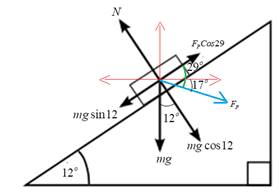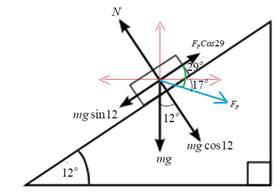
A grocery cart with mass of 16 kg is being pushed at constant speed up a 12o ramp by a force Fpwhich acts at an angle of 17o below the horizontal. Find the work done by each of the forces
Part (a)
The work done by the gravitational forces on the cart
Answer to Problem 12P
Solution:The work done by the gravitational forces on the cart is -244.5 J
Explanation of Solution
The various forces acting on the cart are shown in the figure.

Given: Mass of the cart,
Angle of inclination of ramp,
Length of ramp,
Formula used:
Calculation:
Work done the gravitational forces on the cart is
The negative sign indicates that weight opposes the upward motion.
Conclusion:The work done by the gravitational forces on the cart is
Part (b)
The work done by the normal forces on the cart.
Answer to Problem 12P
Solution:The work done by the normal forces on the cart is zero
Explanation of Solution
The various forces acting on the cart are shown in the figure.

Given: Mass of the cart,
Angle of inclination of ramp,
Length of ramp,
Formula used:
Calculation:
The normal force is acting perpendicular to the ramp, θ = 90o.
The work done by the normal forces on the cart is zero
Conclusion:The work done by the normal forces on the cart is zero
Part (c)
The work done by the applied forces on the cart
Answer to Problem 12P
Solution:The work done by the applied forces on the cart is 244.5 J
Explanation of Solution
The various forces acting on the cart are shown in the figure.

Given: Mass of the cart,
Angle of inclination of ramp,
Length of ramp,
Formula used:
Calculation:
The work done by the applied force on the cart is
Conclusion:The work done by the applied forces on the cart is 244.5J.
Chapter 6 Solutions
Physics: Principles with Applications
Additional Science Textbook Solutions
College Physics: A Strategic Approach (3rd Edition)
Applications and Investigations in Earth Science (9th Edition)
Human Physiology: An Integrated Approach (8th Edition)
Chemistry: The Central Science (14th Edition)
Chemistry: An Introduction to General, Organic, and Biological Chemistry (13th Edition)
Campbell Biology (11th Edition)
- The cylindrical beam of a 12.7-mW laser is 0.920 cm in diameter. What is the rms value of the electric field? V/marrow_forwardConsider a rubber rod that has been rubbed with fur to give the rod a net negative charge, and a glass rod that has been rubbed with silk to give it a net positive charge. After being charged by contact by the fur and silk...? a. Both rods have less mass b. the rubber rod has more mass and the glass rod has less mass c. both rods have more mass d. the masses of both rods are unchanged e. the rubber rod has less mass and the glass rod has mroe massarrow_forward8) 9)arrow_forward
- Lab 8 Part 3 PHET Wave Interface simulation. I am having trouble with this part of the lab.arrow_forwardMick and Rick are twins born on Earth in the year 2175. Rick grows up to be an Earth-bound robotics technician while Mick becomes an intergalactic astronaut. Mick leaves the Earth on his first space mission in the year 2200 and travels, according to his clock, for 10 years at a speed of 0.75c. Unfortunately, at this point in his journey, the structure of his ship undergoes mechanical breakdown and the ship explodes. How old is Rick when his brother dies?arrow_forwardHi, I have canceled, why did you charge me again?arrow_forward
 College PhysicsPhysicsISBN:9781305952300Author:Raymond A. Serway, Chris VuillePublisher:Cengage Learning
College PhysicsPhysicsISBN:9781305952300Author:Raymond A. Serway, Chris VuillePublisher:Cengage Learning University Physics (14th Edition)PhysicsISBN:9780133969290Author:Hugh D. Young, Roger A. FreedmanPublisher:PEARSON
University Physics (14th Edition)PhysicsISBN:9780133969290Author:Hugh D. Young, Roger A. FreedmanPublisher:PEARSON Introduction To Quantum MechanicsPhysicsISBN:9781107189638Author:Griffiths, David J., Schroeter, Darrell F.Publisher:Cambridge University Press
Introduction To Quantum MechanicsPhysicsISBN:9781107189638Author:Griffiths, David J., Schroeter, Darrell F.Publisher:Cambridge University Press Physics for Scientists and EngineersPhysicsISBN:9781337553278Author:Raymond A. Serway, John W. JewettPublisher:Cengage Learning
Physics for Scientists and EngineersPhysicsISBN:9781337553278Author:Raymond A. Serway, John W. JewettPublisher:Cengage Learning Lecture- Tutorials for Introductory AstronomyPhysicsISBN:9780321820464Author:Edward E. Prather, Tim P. Slater, Jeff P. Adams, Gina BrissendenPublisher:Addison-Wesley
Lecture- Tutorials for Introductory AstronomyPhysicsISBN:9780321820464Author:Edward E. Prather, Tim P. Slater, Jeff P. Adams, Gina BrissendenPublisher:Addison-Wesley College Physics: A Strategic Approach (4th Editio...PhysicsISBN:9780134609034Author:Randall D. Knight (Professor Emeritus), Brian Jones, Stuart FieldPublisher:PEARSON
College Physics: A Strategic Approach (4th Editio...PhysicsISBN:9780134609034Author:Randall D. Knight (Professor Emeritus), Brian Jones, Stuart FieldPublisher:PEARSON





